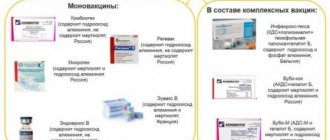What are the names of the first vaccines given to newborns in the maternity hospital?
The first vaccination in the maternity hospital is carried out 4-6 days after birth. The drug used promotes the development of the correct response of the immune system to pathogens that cause the development of tuberculosis. For immunization, types of vaccines such as BCG and BCG-M can be used.
The first option contains twice as much pathogen protein (antigen) as the second. The listed drug options contain live attenuated bovine mycobacteria. The drug for immunization against tuberculosis is available in dry form.
Only healthy newborns weighing more than 2500 g are vaccinated with BCG. Premature infants weighing over 2000 g, newborns who have developed hemolytic disease or have disorders in the nervous system, as well as children who, for any reason, do not were vaccinated in the maternity hospital and given BCG-M.
Vaccine injection site
The World Health Organization recommends placing the BCG vaccine on the outer side of the left shoulder, on the border between its upper and middle third. In Russia, BCG is administered in exactly this way - into the shoulder. The vaccine preparation is administered strictly intradermally; subcutaneous or intramuscular injection is not allowed.
If there are any reasons why the vaccine cannot be injected into the shoulder, then another place with sufficiently thick skin is selected where the injection is placed. As a rule, if it is impossible to place BCG in the shoulder, it is injected into the thigh.
Shoulder vaccination: what is it given at birth?
Both BCG and BCG-M are vaccinations designed to protect against primary forms of tuberculosis, as well as more dangerous extrapulmonary manifestations of the disease (bone lesions and meningitis), which are difficult to diagnose and treat.
If a mother signs a written refusal to undergo vaccination, she must understand how much risk she is exposing her child to.
In such a situation, you should carefully monitor who the child comes into contact with and, if possible, avoid any interaction with infected people. In this case, it is impossible to guarantee that in the future the newborn will not encounter an infection and become infected.
Children who have been immunized can also become infected. But thanks to their developed immunity, the disease occurs in a mild form, after which it heals spontaneously.
Complications of vaccination
Complications are those conditions that do not occur during the body’s normal response to vaccination.
- Prolonged fever. This is an increase in temperature of more than 37.5 degrees, lasting more than a day.
- Local complications. These include all conditions that occur at the injection site - the skin swells and turns red, the injection festers, and an abscess forms.
- Inflammation of the lymph nodes. The nodes in the armpit area and on the neck enlarge and become dense. The skin over them usually does not turn red and is not hot to the touch. The nodes are painless.
- Keloid scar. At the injection site, wound healing occurs through the formation of a rough scar. It measures more than 1 cm and is bright red in color.
- Allergy. It manifests itself in the form of a rash like urticaria and itchy skin. In more severe cases, Quincke's edema and anaphylactic shock develop.
The most severe complications include the development of generalized BCG infection. It occurs due to excessive activity of the live component of the vaccine. Internal organs and bones are affected. Complications arise when the rules of vaccination or vaccination are violated in the presence of contraindications. If signs of complications appear, you should consult a doctor. The child requires consultation with a phthisiatrician.
What vaccination leaves a mark on the left shoulder?
The vaccine is administered strictly intradermally using a special tuberculin syringe. After 4-6 weeks during the initial administration and already in the first week during revaccination, a small spot appears at the injection site, and then a thickening appears.
Provided the process is normal, the size of the formation does not exceed 5-10 mm . Afterwards, a transparent purulent blister appears at this place, the contents of which gradually become cloudy.
The last stage is the formation of a crust at the injection site. After 5-6 months, most children develop a small (3 to 10 mm) scar in this place, which takes on its final appearance by the age of one year.
It is impossible to smear the inflamed injection site with iodine, apply various compositions to it intended to eliminate pus and heal wounds, rub the injection site with a washcloth or rip off the resulting crust.
In this way, the natural process of local infection can be disrupted, which will not allow the body to form the correct immune response.
Normal reaction
The effectiveness of vaccination is judged by how the injection site changes. The first changes appear within a month. First, a red spot appears at the injection site. The norm is if the spot is no more than 1 cm in size. Gradually, this area swells, and a small abscess appears in its center. After 5–7 days, the abscess becomes covered with a crust, and after another week it disappears.
Then, over the course of 6 months, a scar forms at the injection site. Its length is 0.3–1 cm and its color is white. If all conditions are met, we can talk about the effectiveness of BCG vaccination in newborns and the formation of good immunity. The scar should be clearly visible on the skin. It persists throughout life.
The reaction to the vaccine develops within a month
How to get rid of a scar on the forearm that was left from childhood from smallpox vaccination?
This question interests many people. Moreover, representatives of the fair sex ask it much more often than men. The relevance of this issue is well founded. After all, a low-aesthetic formation does not adorn any forearm.
Today, there are several ways to restore the beauty and uniformity of the skin structure at the site of vaccine injection.
However, before undergoing cosmetic procedures, the following points should be taken into account:
- The pustule should heal completely. Until this moment, touching the formation and carrying out even the slightest cosmetic measures in its area is prohibited;
- the scar does not pose a danger to life or health. Therefore, you can calmly live with it all your life without exposing your body to unnecessary cosmetic effects.
If the scar does not give you peace of mind aesthetically, the following measures can be taken to eliminate it:
- chemical peeling . Several procedures will be required to obtain results. In the process of treating the scar, salicylic, trichloroacetic, and glycolic acid will be used;
- mechanical grinding . In this case, the top layer of the skin will be polished using attachments with the smallest diamond coating. After a cycle of such procedures, the scar will be smoothed out, and the skin at the injection site will become even and smooth;
- laser resurfacing . The use of a laser activates the growth of new cells of the epithelial layer;
- phenol peeling . The procedure is painful, but very effective. Aggressive substances are used to correct the skin.
How can you refuse vaccination?
The question of whether newborns should be vaccinated in the maternity hospital can only be answered by parents who are fully responsible for the health and life of the baby. It can be noted that previously all healthy born children were vaccinated. Nowadays, the consent of mom or dad is required.
After the neonatologist has completely examined the child, and the mother has had some rest from childbirth, a nurse approaches her to obtain consent for vaccination. It is necessary to sign papers stating that the parents are familiar with possible complications.
If you consider it pointless to vaccinate newborns in the maternity hospital, your right is to write a refusal. Then a corresponding entry will appear in the baby’s card, and the district pediatrician will have to draw up an individual vaccination schedule.
Video on the topic
Everything you need to know about the vaccine scar on your left shoulder is in the video:
Vaccination against tuberculosis is an important event for every modern person. This is reliable protection against dangerous diseases and the so-called guarantee of your child’s well-being for a long period of life. Therefore, you should not refuse to carry out this procedure for the sake of beauty.
In Soviet times, citizens were required to be vaccinated against two diseases that were especially dangerous to human health: smallpox and tuberculosis. Upon careful examination of the left shoulder, people born before 1979 will notice two scars, which are evidence of vaccination.
The last case of smallpox infection was reported in Bangladesh in 1978. It is believed that from this moment on, humanity defeated the disease. In Russia, babies born after 1980 are given only a vaccine against tuberculosis, which is accompanied by the formation of one scar.
Adverse reactions
Vaccination with a live vaccine is always accompanied by a temporary deterioration in the baby’s well-being. Normal side effects include:
- temperature rise to 37.5 degrees;
- redness and swelling of the injection site;
- lethargy, lack of appetite;
- increased sleepiness of the baby.
This condition lasts for 24 hours after vaccination. To reduce the severity of side effects, the child is given an antipyretic and antihistamine.
What causes the appearance of scars or their absence?
Vaccinations against the listed diseases are carried out with live vaccines. The injection is carried out in the left shoulder under the skin. The child’s body’s natural response to foreign antigens is an inflammatory process in the area where the vaccine was administered. During the normal course of the reaction, a pustule (swelling) is formed at the injection site, which is filled with a transparent liquid substance.
Gradually it turns red, suppuration forms, the blister bursts, and a crust appears. The “aging” process lasts from 2 to 6 months and ends with the formation of a scar.
Pediatricians recommend that parents not interfere with the processes occurring on the shoulder. Forbidden:
- treat the source of inflammation with disinfectants and antibiotic ointments;
- scratch the pustule, peel off the crust;
- apply bandages to the seal.
A small defect ranging in size from 2 to 5 mm, which persists for many years, does not affect the quality of life of a child or an adult, but allows protection against a fatal disease.
It is extremely rare that a necrotic process of capillaries occurs with the formation of a keloid scar. It constantly increases in size due to the growth of the capillary network, periodically itches and hurts.
The problem is that it cannot be removed surgically; the process is stopped with chemotherapy or radiotherapy.
There may be no trace of the vaccination. For example:
- if the child has innate immunity capable of neutralizing the introduced mycobacteria;
- if the injection is placed incorrectly in the deeper subcutaneous layers;
- with rapid skin regeneration.
The absence of a scar is a reason for parents to contact a pediatrician to find out the reasons and then correct the actions. In case of some contraindications (immunodeficiency, contact with a sick relative), children are not vaccinated.
BCG vaccination for newborns
In different centuries, humanity has faced enormous challenges in the form of various epidemics that claim millions of thousands of human lives. The Middle Ages are mentioned in history as the time when the syphilis epidemic occurred; in different centuries - for the first time in the 6th and finally in the 19th centuries - humanity was overtaken by three plague epidemics one after another; at the beginning of the 20th century, polio became a terrible disease that affected hundreds of thousands of people... Some of these diseases are now a thing of the past, like a terrible reminder of history. Others have migrated to our time, but fortunately, now doctors have learned to prevent them and deal with them.
Tuberculosis and BCG - a little history
The same can be said about tuberculosis, a terrible disease that killed a huge number of people from different countries and different ages in the 19th century. At that time, tuberculosis was known as “consumption,” and it spared neither the young nor the old, nor the poor, nor representatives of royal dynasties.
Transmitted by airborne droplets, tuberculosis is transmitted unnoticed, but soon takes on a form that is threatening to health and life. Primarily affecting the lungs, the infection can also overtake bone tissue, joints, and other organs. And tuberculosis is especially dangerous for young children: accompanied by anemia and dystrophy, the infection can overtake the membranes of the brain, and then we are talking about tuberculous meningitis, and life is counted in seconds...
Fortunately, today, for a century now, a fairly effective method of preventing the spread of this complex and terrible disease has been used - vaccinating children against tuberculosis almost from birth. The anti-tuberculosis vaccine BCG was created at the beginning of the 20th century by French scientists Calmette and Guerin. In honor of their names, the vaccine itself received the name: Bacillum CalmetteGuerin - BCG, in Russian transcription BCG. After many years of work on improving the vaccine (which at first caused too many complications), BCG received the form in which it is now used everywhere as the most effective means of preventing tuberculosis.
Babies are vaccinated against tuberculosis in the first days after birth - still in the maternity hospital, on days 3-7. If mandatory vaccinations were not given after birth for one reason or another, it is recommended that the child be vaccinated in a clinic setting. In principle, vaccination against tuberculosis, according to the Vaccination Calendar, is mandatory, but at the same time, parents can independently decide to refuse vaccination. At the same time, they must take into account: tuberculosis is an insidious disease, for children with an immature immune system it is doubly dangerous, while vaccination reduces the risk of morbidity several times. Doctors warn: vaccination does not guarantee that a child will not be infected, but after vaccination, his body is already familiar with the infection, acquires a certain immunity, which means that the development of severe forms of tuberculosis and the transition of the disease from a latent form to an active one are prevented.
As already mentioned, BCG vaccination for newborns is indicated 3-7 days after birth; the vaccine is administered subcutaneously into the left shoulder. The BCG vaccine contains a weakened strain of specially treated tuberculosis bacilli - “half-live”, which do not cause infection, but instead contribute to the production of protective antibodies against tuberculosis. The BCG vaccine is used to vaccinate full-term and healthy babies, and a “lighter” version of the BCG-M vaccine is provided for premature and weakened babies. Immunity after vaccination takes up to a year to develop and lasts for 5-7 years. That is why revaccination is often recommended for children at the age of first 7 and then 14 years old - in case of a negative Mantoux reaction.
The reaction of a small organism to a BCG vaccination, if everything is normal, is always the same. So, 2-3 months after vaccination, a so-called infiltrate forms on the skin at the site of vaccine administration - compaction or thickening, similar to a mosquito bite. The infiltrate can take the form of a fluid-filled vesicle, which sooner or later bursts and a crust forms in its place. Under no circumstances should this crust be removed - it will come off on its own. In addition, you should not lubricate the vaccination site with brilliant green, iodine, alcohol, or any other antiseptic drugs. By six months, as a rule, a neat scar has formed at the injection site, which will take on its final appearance by the age of one year.
Contraindications for BCG vaccination
Any vaccination, including BCG vaccination, is given to children only if there are no contraindications. Otherwise, the effect of vaccination will be exactly the opposite - it will only do harm, and sometimes extremely significantly. So, there are also certain contraindications to the BCG vaccination: absolute and relative.
Thus, absolute contraindications, in which vaccination is not carried out at all, are:
- the child has congenital or acquired immunodeficiency conditions;
- congenital enzymopathies, severe hereditary diseases (for example, Down syndrome), complex lesions of the central nervous system;
- if close relatives of the newborn experienced complications after BCG vaccination;
- if the child has already been diagnosed with tuberculosis.
Relative contraindications, in which the BCG vaccination procedure is slightly delayed, include:
- any infectious diseases;
- skin diseases;
- hemolytic disease of newborns;
- severe degree of prematurity.
Possible complications after vaccination
The most serious complication of anti-tuberculosis vaccination can be infection of the infant. Such cases are very rare and occur, as a rule, due to improper selection of children for vaccination and ignoring contraindications.
As a result of improper selection for vaccination and the presence of disorders in the child’s immune system, osteitis may develop as a result of BCG vaccination, an inflammatory process that occurs in bone tissue.
However, more often milder complications are recorded, which are the result of incorrect and illiterate administration of the vaccine. These include:
- ulceration, increase in size and suppuration of the infiltrate;
- formation of subcutaneous infiltrate - when the infiltrate is formed not in the skin, but under it, where it can be felt like a ball. This happens if the vaccine was injected too deeply; if a subcutaneous infiltrate is detected, you should consult a doctor immediately - it can break inside with infection entering the bloodstream;
- spread of infection to the lymph nodes. In this case, the lymph nodes (usually axillary) enlarge to the size of a walnut, and sometimes even a chicken egg, and are painfully palpable. The infection can sometimes break out, resulting in the formation of a fistula - a channel through which pus is separated;
- in newborns it is less common, but in older children a keloid can form: this condition is characterized by excessive growth of scar tissue.
Be that as it may, the appearance of any of the above symptoms requires a mandatory consultation with a phthisiatrician.
Especially for malutka.net Tatyana Argamakova
malutka.net
What vaccinations leave traces?
A vaccination scar occurs in two cases: when a child is given BCG or a smallpox vaccination (not done since the 80s). Let's take a closer look at these situations:
In older people, a scar reaching 1.5 cm with uneven edges and structure is noticeable on the left shoulder. It is recessed in relation to the rest of the skin surface. This is a trace from vaccination with an anti-smallpox drug.
In the maternity hospital, newborn babies are vaccinated with mycobacterium tuberculin (BCG) on days 3–7 with the consent of the parents. The vaccine contains live weakened tuberculin bacilli grown in a cow's body.
They are not capable of causing disease, but provoke the production of antibodies that last 5–7 years. After healing, a small, inconspicuous scar remains.
When re-vaccinating with BCG, a second trace of the vaccination usually does not remain. This is due to the fact that the response to a foreign substance is not so pronounced at the age of seven. At first the scar is red, then it turns blue, gradually merging with the general background of the skin.
Some particularly sensitive babies may be left with a second scar on the child's left arm, caused by an intense inflammatory reaction at the injection site.
What could be the consequences?
Before vaccination, the specialist is obliged to inform parents about the possible consequences, provided contraindications are not observed, and how the injection site is healing. The consequences are short-term and permanent. Of particular danger are complications that can leave an imprint on the baby’s entire life.
So, what consequences of BCG vaccination are considered dangerous:
- Lymphadenitis. It is formed as a result of the penetration of microbacteria into the human lymphatic system. If complications occur, surgery may be required;
- Osteomyelitis. Formed as a result of injection of a low-quality vaccine. Healing of the left shoulder from three months to a year;
- Abscess. Rotting of the skin;
- Skin ulcer at the injection site. It arises as a result of the incompetence of medical staff who administered the BCG vaccination when there were contraindications. The problem can be eliminated using standard medical methods using stationary medications. Repeated administration of the vaccine is strictly prohibited.
Of course, possible complications may frighten parents, and they will be against vaccination, because they value their children. It is important to remember that the BCG vaccination will prevent the development of such a serious disease as tuberculosis, which can harm the child much more.
How to prevent scarring
The scar confirms the body's correct response to the vaccine. Its size serves as an indicator of the presence of immunity against the disease. The presence of a scar helps doctors determine the number of injections against tuberculosis if the vaccination certificate is lost.
BCG vaccination will not be accompanied by the formation of scar tissue in several cases:
- parents refused to vaccinate their child. At the same time, they risk the health of the baby, since it can serve as a carrier of the tuberculosis bacillus for a long time in the absence of manifestations of the disease;
- The vaccine is made into the muscle layers. Over the course of 1.5 months, an abscess develops, accompanied by inflammation and fever. It is removed by surgery;
- thin skin on the arm is an indication for choosing a different area for the vaccine. For example, they graft on the thigh, since the skin has a denser structure.
The scar will be less noticeable in people whose dermis is not prone to forming scar layers.
Fatal outcome from tuberculosis
Mortality rates from tuberculosis and the number of deaths caused by heart disease and cancer are recorded separately in statistics. In countries where tuberculosis is widespread, women die from this infection more often than from complications after pregnancy. Therefore, this disease is a very important problem.
In the territory of the former USSR, the task of combating tuberculosis was set a long time ago. Despite this, the disease has now become widespread, and the number of deaths is actually equal to that of the poorest countries in Asia and Africa. In order to reduce the risk of developing symptoms of tuberculosis, vaccinations are carried out.
BCG vaccination allows you to build immunity to tuberculous manifestations of meningitis and the disseminated form and in 85% of cases to avoid the disease.
Even if infected with tubercle bacilli, vaccinated children have a great chance of recovery without negative results or complications.
It should be noted that the BCG vaccination prevents the appearance of tuberculosis only up to the age of twenty, after which the effect of the vaccine ceases. Secondary administration of the vaccine does not increase immunity to the disease, so there is no need for revaccination.
BCG vaccination does not reduce the spread of tuberculosis infection, but protects the child’s body from serious complications leading to death. Tuberculosis poses a particular risk in infants: they usually do not survive such cases.
In accordance with the conclusion and recommendations of the World Health Organization, BCG vaccination is necessary for the following categories of people:
- children under 1 year of age who are constantly located in areas with a high prevalence of tuberculosis;
- school-age children living in areas where the disease is spread;
- in contact with patients.
When is it done?
What vaccination is given in the shoulder in the maternity hospital and when? The BCG vaccination is given in the maternity hospital on the 4-6th day of the child’s life. At this age, it is given to children whose weight is at least 2500 grams. There is also the BCG-M vaccine - this vaccine contains half as much antigen. BCG-M is given to children who have contraindications to BCG vaccination. For example, premature babies weighing more than 2 kg, children with an affected central nervous system, as well as those children who were not vaccinated in the shoulder at the maternity hospital.
When should you not get the vaccine?
There are cases when vaccinations in the maternity hospital cannot be given to newborns. They can be temporary or permanent. In the case of the BCG vaccine, this is:
- the presence of HIV infection in the baby or parents;
- poor reaction to vaccination in close family members;
- damage to the baby’s nervous system during labor;
- severe hereditary diseases.
Temporary contraindications include:
- low Apgar score during childbirth;
- the child's weight is less than 2 kilograms;
- intrauterine infection during gestation;
- skin disorders (ulcers, severe rash, severe dermatitis);
- the presence of allergic reactions.
In all these cases, it is not worth vaccinating the child. It is necessary to wait for a complete examination of the baby and the pediatrician’s conclusion.
How is it made?
Parents who know what the shoulder vaccine is for should also become familiar with the technique of administering it. Before giving the injection, it is diluted with a special physiological solution, which is included with the vaccine. To vaccinate, a special tuberculin syringe is used. The vaccine is administered intradermally into the left shoulder. A month and a half after vaccination, a spot appears on the site, then an infiltrate, that is, the tissue area increases in volume and becomes dense, with a diameter of no more than 5-10 mm. Then a bubble forms - an abscess; it should be no more than a centimeter in size. The contents of the bubble are transparent or slightly cloudy, then a crust will appear.
Possible complications and their causes
Causes of complications after vaccination:
- incorrect procedure technique;
- vaccination without taking into account the child’s personal characteristics and contraindications
When giving a child BCG vaccination, parents should be prepared for complications:
- Abscess. If a mistake was made during the procedure and the drug got under the skin, a cold abscess will occur. The infiltrate can open without surgery, but not always.
- Lymphadenitis. The cause of the complication is the excess of the permissible level of pathogenic bacteria. The reaction is caused by an overdose of the vaccine or its increased potency. Inflammation originates in the left axillary zone - it is closest to the vaccination site.
- Keloid scar. This complication manifests itself a year after the injection. The scar may be growing or non-growing. In the first case, compaction occurs in the tissues, an enlargement of the scar and a purple coloration. Pain and unbearable itching appear.
- Generalized BCG infection. A complication occurs with congenital immunodeficiency. The body is unable to protect itself and is susceptible to various infections. If measures are not taken in time, the complication will end in death.
- Post-vaccination syndrome. It is characterized by skin rashes and is a late reaction.
- Osteomyelitis is another one of the most severe complications. Signs of the disease often appear within a year. The lesion begins with tubular and spongy bones, collarbones and ribs. The lower extremities are most affected.
Vaccine scar on shoulder
After 5-6 months, the child will develop a scar 3-10 mm long. The scar indicates that the vaccine has been vaccinated and that the body has produced specific protection against Mycobacterium tuberculosis. The place where the vaccination was given should not be touched, smeared with antiseptics, or bandaged. Even if the bubble has opened, you still should not touch it under any circumstances; after a while it will dry out and a crust will form.
Possible reactions
After BCG vaccination in the maternity hospital, the newborn’s body may react with the following changes in health:
- loose stools, frequent regurgitation, slight increase in body temperature;
- redness of the vaccine injection site, slight swelling;
- a small scar on the skin that forms 1-1.5 months after the vaccine is administered.
These effects are considered a healthy response by the body to BCG administration. Pathological complications include fever above +38.5°C, febrile convulsions, loss of consciousness, suppuration at the injection site. If the vaccination was done in the maternity hospital, the medical staff will help the child. If vaccination was carried out later, parents will have to seek help from a medical institution.
TB doctor
If the wound is very large (more than 10 mm), the shoulder hurts after vaccination, or a bubble has not formed at the vaccination site, you should contact a phthisiatrician. A phthisiatrician is a doctor who diagnoses, prescribes treatment or prevents tuberculosis. If the child was not vaccinated for some reason in the maternity hospital at 4-6 days, then it is necessary to vaccinate him after the contraindications are removed. If you need to give BCG to a child older than 2 months, first they do the Mantoux test. If the Mantoux test is negative, then the child can have BCG, but not earlier than 2 weeks after the Mantoux test. Also, parents should not forget that if the child was brought home from the maternity hospital, he should not have contact with people who have not undergone fluorography.
Vaccination rules
The vaccine is given to the baby while still in the maternity hospital. The very first vaccination - against hepatitis B - is done on the first day. On the third day, if the child is healthy, he is vaccinated against tuberculosis. The next vaccination is carried out only at the age of 7 years. The condition for this is annual negative Mantoux tests. If the Mantoux test is positive, this means that the child has come into contact with Mycobacterium tuberculosis. In this case, you cannot vaccinate the baby.
There is only one place where the baby is vaccinated - the upper third of the left shoulder on the outside. The vaccine itself is a powder that must be diluted with sodium chloride solution. The injection is given intradermally using an insulin syringe. Only a trained professional, such as a doctor or nurse, can administer the injection. The next preventive vaccination is possible only after a month and a half. If for some reason the vaccination was not carried out in the maternity hospital, it is done at the clinic at the place of residence. Before vaccination, a Mantoux test is done.
Revaccination
After you have found out what the vaccine in the shoulder (left) is for, you should find out what revaccination is. Repeated vaccination is given at the age of over 6 years. In order to consolidate the result and to develop lasting immunity to tuberculosis pathogens. Before re-vaccination, the child is given a test Mantoux vaccination. The Mantoux test is a test for developing immunity to tuberculosis. This is the safest diagnostic method, at least safer than a lung x-ray. If the test is positive, then there will be swelling, redness and induration at the grafting site with a diameter of 10 mm. This means that the child’s body had contact with the tuberculosis pathogen, but this is not an indicator that the child is sick. If there is such a reaction, then the child should be under the supervision of a pediatric pulmonologist and pediatrician. The time between Mantoux and BCG vaccinations ranges from 3 to 14 days.
Vaccination at birth in the shoulder is contraindicated for children who were born with some kind of complications, this could be an intrauterine infection, primary immunodeficiency and HIV in the mother and other serious diseases. The mother must decide whether to vaccinate in the maternity hospital or later, and if there are any contraindications, she should be told about this by a neonatologist pediatrician who examines the child in the first minutes of his life.
Repeated BCG vaccination (at 6-7 years old) can be postponed if the child has allergies, immunodeficiency, cancer or other acute diseases. If the Mantoux reaction was positive during the first vaccination, then repeated vaccination is done with extreme caution. A healthy child does not develop complications after BCG. But do not forget that any medical drug can give an unexpected reaction when exposed to an individual organism, that is, this can happen individually. Sometimes it is difficult to diagnose some disease in a child before a vaccine, and then the vaccination given results in undesirable consequences for the child. And it turns out that the child was vaccinated when the child was sick, but no one knew about it.
BCG vaccination in newborns: what is the reaction and what to do if it was not done in the maternity hospital?
BCG is a vaccine against a fatal form of tuberculosis. The abbreviation BCG is of French origin and stands for Bacillus Calmette-Guerin.
BCG in a child's vaccination schedule
In Russia, BCG is included in the preventive vaccination calendar and is widely used in a number of European countries, India and Brazil. A vaccine is a combination of a number of live and inactive bacteria that cause a protective response in the body and further form immunity against the disease.
Today, the question of the advisability of vaccination for newborns is increasingly being raised. BCG was originally created to completely protect against tuberculosis infection. But as cases of infection were subsequently identified in people who received the vaccine in infancy, the opinion about it was adjusted.
The results of studies on the dependence of the development of tuberculosis on vaccination in different countries differ significantly. For example, in India, most of the cases are among those who were previously vaccinated. In the United States, it was concluded that the vaccine was 14% effective.
Russian doctors are of the opinion that immunization cannot guarantee complete protection against tuberculosis, but aims to prevent its development in severe form in 85% of cases.
BCG vaccination among newborns is recommended under the following circumstances:
- The child lives in a region where tuberculosis is widespread.
- The baby has a high risk of infection from the environment, while living in a region with a low prevalence of this disease.
The BCG vaccination is one of the first given to a newborn. In the absence of contraindications, vaccination is carried out on days 3-7 of the baby’s life, a few days after vaccination against hepatitis B. In the maternity hospital, BCG is administered intradermally to the child into the outer surface of the left forearm.
It is prohibited to inject intramuscularly or subcutaneously. If there are contraindications for an injection into the shoulder, the thigh is chosen for this as the place with the thickest skin.
BCG is recommended to be done already in the maternity hospital, because the risk of encountering a tuberculosis infection arises immediately after discharge. According to statistics, 2/3 of the Russian population are carriers of mycobacteria of this disease, without experiencing any symptoms.
Tuberculosis develops in only 5-10% of those infected, but when sneezing and coughing, the bacteria enter the environment. This poses a threat to the newborn, who still has an imperfect immune system.
The sooner a child is vaccinated, the faster an immune response will form. And in order for the newborn’s body to successfully cope with local tuberculosis, other preventive vaccinations should be done only a month later.
Normal reaction and possible complications
BCG vaccination is successful in newborns in more than 99.8% of cases. Moreover, 90% of the negative consequences are due to congenital immunodeficiency of children. A delayed reaction to BCG is considered normal, which begins after 1-1.5 months, lasts for 4.5 months and consists of the following:
- At first, the grafting site turns red, then it may darken and turn blue, purple, and even black.
- An abscess forms in the center of the redness, protruding above the skin. The center of the abscess becomes covered with a crust.
In some cases, suppuration does not occur, only a light bubble appears. Then it also becomes crusty and tightened.
- It happens that the abscess breaks out once or twice. This is normal and should not be a cause for concern.
Such breakouts should not be treated with antiseptics; it is better to simply blot them with a clean gauze cloth. Under no circumstances should you squeeze out the contents of the abscess with your hands.
- When the suppuration passes, a small red pimple will appear at the injection site, which will soon transform into a characteristic scar, the appearance of which is familiar to everyone.
Vaccination against tuberculosis is tolerated individually by each newborn, and the reaction may have features that you should be aware of:
- Normally, redness can be observed at the injection site before and after suppuration before scar formation. It should not extend beyond the surrounding tissue and extend to the shoulder.
- An abscess and suppuration are normal if there is no swelling or redness. Otherwise, the wound is infected and requires consultation with a specialist. If suppuration occurs several times, the child must be examined.
- The BCG vaccination site may be swollen for 2-3 days immediately after the injection. In the future, the reaction should not be accompanied by swelling.
- It often happens that the injection site itches, and such sensations are normal. But you should not scratch the vaccine; it is better to cover it with a gauze napkin or put the scratches on the newborn’s hands.
- During the development of an abscess, the baby’s temperature can rise to 37.5°C - in this case there is no need to worry.
Sometimes a scar does not appear at the vaccination site after 4.5 months. This happens in two cases:
- the vaccination had no effect;
- the child has innate immunity against tuberculosis.
In rare cases, BCG vaccination leads to complications associated with severe deterioration in the health of the newborn. It could be:
Feedback from our reader - Anastasia Makarova
I recently read an article that talks about the Monastic gathering of Father George for the treatment and prevention of tuberculosis. With this collection you can not only cure tuberculosis FOREVER, but also restore your lungs at home.
I’m not used to trusting any information, but I decided to check and ordered a package. I noticed changes within a week: I felt a surge of strength and energy, my appetite improved, the cough and shortness of breath receded, and after 2 weeks they disappeared completely. My tests came back normal. Try it too, and if anyone is interested, below is the link to the article.
Read the article —>
- A cold abscess is a large accumulation of pus in a small area. It is caused by an injection given not subcutaneously, but not inside the epidermis. Requires the intervention of a surgeon.
- When a child is allergic or particularly sensitive to the components of the drug, an ulcer larger than 10 cm in size may occur at the injection site. In this case, treatment is carried out with special ointments.
- Inflammation of the lymph node is associated with the widespread spread of bacteria when the child’s immunity does not cope with the vaccine properly.
- A keloid scar is severe redness and swelling of the skin at the injection site. In case of such a complication, subsequent vaccination is prohibited.
- Generalized BCG infection is a rare case of severe complication associated with the immunodeficiency virus in a newborn.
- Bone tuberculosis - osteitis, develops in 1 case out of 200,000 vaccinations, occurs due to disorders of the immune system.
In order to avoid complications, each newborn is observed by a neonatologist.
Contraindications and features of vaccination
In Russia, contraindications to BCG vaccination in newborns are as follows:
- The baby weighs less than 2.5 kg at birth.
- There is an immunodeficiency in the child or mother.
- Doctors diagnosed a generalized BCG infection to one of his closest relatives.
- Intrauterine infections, hemolytic disease, serious skin pathologies, and neurological problems have been recorded.
- Newborns have tumors of any size.
BCG should not be given to premature babies weighing less than 2 kg. For such babies, the maternity hospital provides the BCG-M vaccine, which contains half as much dangerous bacteria.
If the vaccination was not done on time, it can be done later.
There are three reasons why BCG vaccination is delayed and can be carried out for the first time at 2, 3, 4 months, after a year and even later:
- The child's mother refused to vaccinate her child, and then changed her mind.
- Presence of temporary contraindications.
- Lack of vaccine in the maternity hospital.
If the child’s weight after discharge is more than 2300 g, and there are no contraindications, then the BCG vaccination can be done in the vaccination office of the clinic to which the newborn is assigned. It is advisable that the clinic have a specialist specifically in administering this vaccine, in order to avoid the risk of developing a cold abscess due to medical error. It is not permissible to vaccinate in the room where blood tests are taken. If the risk of complications is still present, but doctors recommend vaccinating the newborn, the vaccine is administered in the hospital.
On an outpatient basis, children who have not received the primary vaccine in the maternity hospital are vaccinated with BCG-M. This reduces the risk of complications, but this vaccination forms immunity against tuberculosis only for 7 years, while the BCG vaccine lasts for 15-20 years.
If the vaccination is given before 2 months, it is generally accepted that the child is not infected with tuberculosis. At the age of over 2 months, a Mantoux test must be done before vaccination to confirm the absence of the disease.
At 3 months the child should receive the first DTP vaccine, and at 4 months - the second. If the BCG vaccination has not been done by this time, then you should not combine vaccinations under any circumstances; such a load on the immune system will be unbearable. It is not recommended that vaccination occur during the hot summer, as the likelihood of complications increases significantly.
Vaccination calendar
If the primary BCG vaccination is done annually, then the child will first have to undergo a medical examination. Primary BCG vaccination after a year allows you to carefully prepare for the manipulation by first doing allergy tests for the components of the vaccine, then the child’s body will respond adequately to the BCG vaccination.
However, it should be remembered that late administration of BCG creates a risk of complications in case of tuberculosis infection.
Let us know about it - rate it
OPnevmonii.ru
Possible complications
In such cases, the following complications may occur:
- Increased temperature - it can be 38-38.5 ° C, then you need to give the baby an antipyretic drug, and if on the second day there is a fever again, you need to call a doctor. This reaction can occur in a child with a weak body; his immune system is not strong enough.
- Runny nose, cough or redness of the throat - such a reaction can also occur due to weak immunity. All this can be treated and the child does not need to be hospitalized.
- On the first evening after vaccination, the child may feel tired, lose appetite, and the child may be capricious. If such a reaction occurs, you need to calm the child down, not stuff him with food, provide him with peace and, if possible, put him to bed earlier. Usually these symptoms disappear within a maximum of 3 days.
- If the vaccination site becomes inflamed or begins to fester over time, you should immediately consult a doctor.
All these symptoms are not serious and do not threaten the health and life of the baby.
How to check BCG correctly?
The papule that forms at the vaccination site should normally be up to 1 cm in diameter, and the surrounding skin should look without signs of inflammation. Skin color should be white, pinkish, and reddish is also allowed. If the shade is bright red or brown, then this indicates a side effect.
If the papule does not heal within 3-5 months, then you should consult a doctor.
Any possible fever should not last more than three days from the moment of injection and be accompanied by additional symptoms.
Other reactions to vaccination
There can also be very serious reactions to the vaccine, these are rare but do happen:
- Lymphadenitis is inflammation of the lymph nodes, which is accompanied by enlarged glands and sometimes suppuration. If the lymph nodes are suppurated, they must only be removed surgically, so in case of such reactions the child must be hospitalized.
- Severe suppuration has formed in the injection area, which affects the skin around it. Such a reaction is possible in a child with immunodeficiency, and requires surgical supervision and conservative treatment.
- A cold abscess may also develop. The reason is an incorrectly administered vaccination, that is, the injection was given not subcutaneously, but intramuscularly. Shown 3-4 weeks after vaccination. After this period of time, the wound begins to break through. To prevent such complications, it is necessary to get vaccinated in the office where experienced specialists give vaccinations.
- Osteomyelitis is a bone disease that develops several months after the procedure. The cause may be a poor quality vaccine. Therefore, doctors recommend getting vaccinations only in medical institutions and not buying them from unknown places and from unknown people.
- If the injection was done incorrectly, that is, not intramuscularly, but subcutaneously, a keloid scar will form twelve months after vaccination.
- An ulcer appears at the puncture site - this indicates the sensitivity of the child’s body to the components of the BCG vaccine. An ulcer is dangerous due to infection, so observation by a surgeon is required. This happens very rarely, but it does happen.
From all this we can conclude that the BCG vaccination has serious consequences for the baby, but only if contraindications were ignored, a low-quality vaccine was administered, or the manipulation was carried out incorrectly. If you do everything correctly, then the BCG vaccine is the only real way to protect your child from tuberculosis.
BCG vaccination in newborns: is vaccination mandatory?
BCG is designed to protect the child from tuberculosis and is a weakened mycobacterium of the pathogen. The drug was invented about a century ago, began mass administration to newborns in many countries, and there have been no changes in composition since then.
It is worth noting that in developed countries they are gradually abandoning the use of BCG. It is done only where the statistical incidence of tuberculosis infection is exceeded. The course of vaccinations consists of three procedures: on days 4-7, at 7 and 14 years. Due to the fact that the reaction to the drug is slow and develops only after a month, other vaccinations are prohibited. After vaccination, immunity is acquired for an average of 17 years, and revaccination after that has no effect.
BCG is not able to completely rid an adult’s body of tuberculosis infection, but the drug protects children from severe complications of tuberculosis, which occur quickly and can be fatal. The vaccine is administered intradermally at the border of the upper and middle third of the shoulder, and if this is not possible, then into the thigh. Subsequently, a small scar remains there.
Possible consequences
There are no differences in reactions to BCG vaccination in a healthy baby. Two months after the procedure, you can notice an infiltrate at the injection site - a small compaction similar to a mosquito bite.
Sometimes a water bubble may appear, which will burst and become crusty. The crust should fall off on its own, leaving a scar, and it is prohibited to remove it. Also, the injection site should not be wet in the first days, and lubricated with alcohol or iodine until the end of the reaction. Six months after BCG, a scar will appear at the injection site. Skin itching and temperature up to 38 degrees are also sometimes observed.
All of the above is the body’s standard reaction to the introduction of a vaccine, and there is no reason to worry. The mother’s task is to closely monitor the condition of the injection site and the general well-being of the baby, since in some cases complications are possible after BCG.
Video “Pros and cons of vaccination”
Complications
The most serious consequence after BCG vaccination is infection of the body. This can happen due to ignoring contraindications, including if the wound is wet in the first days. As a result, osteitis, that is, inflammation of bone tissue, is possible. Because of this, quite a lot of people are against the vaccine. Other, milder complications can be observed more often, but they are usually the result of an incorrect injection. In other cases, there are no problems after vaccination.
Complications include:
- enlarged lymph nodes due to infection;
- suppuration and excessive increase in infiltrate, due to too deep penetration of vaccine elements, the formation of a large scar subsequently;
- excessive growth and keloid of the scar in subsequent years;
- cold abscess due to improper administration of the drug (needs surgical intervention).
If any of these reactions occur, parents should consult a TB doctor. You should also consult a doctor if the temperature exceeds 38 degrees.
Contraindications
Like any vaccination, BCG is carried out only when there are no contraindications. There are relative contraindications in which BCG should be postponed, and absolute contraindications in which it cannot be done at all.
Relative:
- severe prematurity of the newborn (weight up to 2 kg);
- hemolytic disease;
- skin or infectious diseases;
- any neoplasms.
Absolute:
- the presence of tuberculosis in a newborn;
- if direct relatives of the baby experienced complications from BCG;
- complex CNS lesions;
- severe hereditary diseases;
- immunodeficiency in the baby or HIV infection in the mother;
- any acute pathologies.
It is possible to vaccinate weak and premature infants with a “lighter” type of drug – BCG-M.
Is it worth doing: pros and cons
The history of BCG vaccinations in the world goes back about a century, and during this time a controversial opinion has formed about the drug against tuberculosis. There have been many studies that have given conflicting results about the effectiveness of the vaccine. It may be noted that studies differ from one country to another. It has been noticed that the further the region is from the equator, the higher its effectiveness against the disease.
You can hear directly opposite opinions about the appropriateness and harmlessness of BCG, both among parents and among doctors.
Arguments against vaccination:
- drugs from some manufacturers can act aggressively in the body;
- storage conditions and expiration dates of vaccines in clinics and maternity hospitals cannot always be checked;
- A baby up to one year old has innate immunity received from the mother, so there is no need for additional immunity against diseases.
Arguments for BCG vaccination:
- after vaccination the baby has no severe manifestations of tuberculosis;
- BCG reduces the risk of infection by 3 times and morbidity by 10 times.
Be that as it may, parents must weigh all the arguments for and against, based on the geographical location of the region, as well as statistics on the incidence of tuberculosis in it. It is also worth paying attention to the qualifications of the medical staff and the equipment of the maternity hospital or clinic.
The opinion that it is difficult to become infected with tuberculosis is erroneous. Many do not even know that they are already asymptomatic carriers, since they have been in contact with mycobacteria in the past. They don’t notice it precisely because in the maternity hospital they were vaccinated with BCG against them and they can even find a scar on their shoulder. Without it, child and adult mortality would be much higher. Well, whether to vaccinate your baby or not is up to you to decide.
Video “Is it necessary to vaccinate newborns”
From the video you will learn what it is, when it is appropriate, and when vaccination should be abandoned. A detailed video tour will answer many of your questions.
LechimDetok.ru
Contraindications to the vaccine
The development of various kinds of complications may be the result of contraindications in the child.
The ban on the introduction of living organisms to newborn children is based on the presence of one of the following factors:
- low baby weight;
- intrauterine infection with pathogenic microorganisms;
- diagnosis of HIV infection in the mother;
- immunodeficiencies of various etiologies;
- diseases of the central nervous system;
- the presence of inflammatory processes in the body;
- active stage of the disease after diagnosis using x-ray photos.
These contraindications are absolute. If they are present, the BCG vaccine is completely prohibited. Vaccination will not provide complete protection against tuberculosis, but it can help develop immune defenses against bacterial agents.
The duration of the drug is on average 7 years. After this period has expired, revaccination must be carried out. Before this, a mandatory Mantoux test is performed.
Before administering the BCG vaccine, you must undergo a full examination by specialized doctors. This will help reduce the likelihood of complications and also protect the child’s health.










